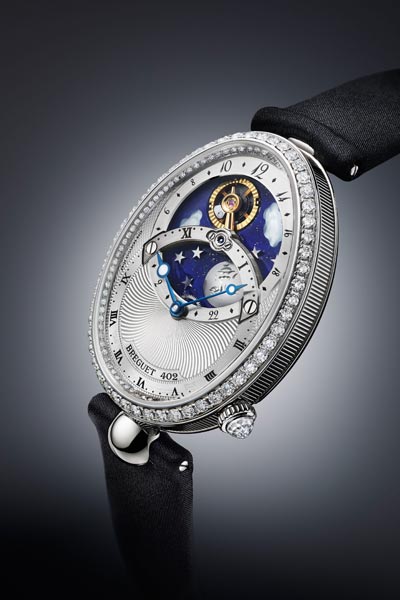When Abraham-Louis Breguet invented the tourbillon, patented in 1801, his conception was resolutely purposeful. All watches were subject to small rate keeping errors caused by gravity, which his invention sought to eliminate by constantly rotating the time keeping elements over 360 degrees. This was a brilliant notion, simple in its core idea, ferociously demanding of savoir-faire for those watchmakers who build them. If by reason of gravitational forces a watch would run faster in some positions and slower in others, rotating the time keeping elements constantly, passing through both the fast and slow positions, serves to average out those errors.
However purposeful the original invention in its establishment of new standards for chronometry, should there not be room in the overall idea of rotation of time keeping components for romance and whimsy? This is the insight that lies behind the Reine de Naples Jour/Nuit. It builds upon the core idea of a tourbillon in that it rotates the balance wheel, its spiral, and escapement over the course of a 24 hour day, but uses that rotation not only to improve time keeping precision, but to present enchanting depictions of both day and night.
The indications of day and night are, logically, built around the images of the sun and moon. Both are set upon a lapis lazuli disk. The image of the moon is the more conventional of the two as it is represented by a carved titanium disk, bearing the face of the man in the moon, which is set into the lapis. Flanking each side of the moon are gold evening stars. It is the sun, however, which is the most as- tonishing for it is represented by the balance wheel of the watch. To heighten the visual presence, the outer rim of the balance is generously wide and decorated with a guilloche pattern. Poised on either side are mother-of-pearl clouds. The lapis disk carrying the balance wheel “sun” and the nighttime moon rotates once every 24 hours. One more function was woven into the day/night display. The upper arm carrying the balance wheel “sun” is in the form of a hand which points to a 24 hour chapter ring encircling the lapis disk. Thus, there is a convenient precise indication of the 24 hour time which is artistically being shown with the sun and moon. More than a supplemental time indication, this hand actually is a key component of the movement as it serves as the bridge holding the balance wheel.

The concept of rotation seems almost trivial: “just turn them”. However, as is the case for any mechanism which proposes to rotate the sensitive time keeping components of a watch, even at the slow speed of one turn per day, the design and assembly imposes stern demands on the watchmaker. To begin with, Breguet’s movement designers had to develop a system which could, on the one hand, rotate the disk carrying the balance wheel (and of course carrying the decorative lapis disk) and, on the other hand, power the escapement of the watch. The solution was to build a power train running from the mainspring barrel which is split; one gear train leading to a pinion to turn the disk (which can be analogized to the “cage” (sometimes referred to as the “carriage” which is used to rotate the timekeeping components of a tourbillon) and a second branch leading to a wheel driving the escapement’s pinion . With this construction, the balance wheel is fixed onto a five spoke titanium cage with small teeth on its outer edge. Of course neither the fine teeth nor the spokes are visible from the dial side of the watch.
The novel placement of the escape wheel in the center of a rotating cage gave birth to an interesting set of design challenges. The first arises from the fact of combined rotations: the rotation of the escape wheel from the running of the watch mixes with the once a day rotation of the cage. This means that over the course of 24 hours, the combination loses 1 turn of the escape wheel. So the problem became how to correct for this “loss” of one turn. The solution was found by fitting the escape wheel with 21 teeth instead of the normal 20 or 15 teeth and fixing the frequency at 3.5 hertz.
There was a second adaptation in the movement design which was required. The placement of the guilloche decorated balance wheel is quite close to the center mounted escape. Although the anchor is of the classic Swiss lever design, its length becomes the shortest of all of Breguet’s movements, and for that matter the shortest of all of the levers of serial produced watches in the industry. The horns of the inverted anchor’s fork, specially designed by Breguet, are fashioned in silicium as is the balance wheel spiral.

From the dial side of the watch all of these complex constructions are hidden. What the owner sees is the lapis disk with its sun, moon, clouds, stars and golden 24 hour hand. Arcing across the lower third of the disk is the chapter ring for regular the 12 hour time indication. Actually, that portion of the chapter ring is a functional part of the movement as it is the upper bridge for the rotating cage. There is a bit of poetry in the combination of the 24 hour and 12 hour chapter rings as they overlap each other forming an outline of the figure eight.
As the creation of these complications should not call for sacrifices in convenience, the Jour/Nuit offers automatic winding. The elaborately decorated gold rotor featuring a carved moon face and gold sun rays rotates on a jeweled bearing system to wind the watch. In order to achieve a flat construction, without sacrificing efficiency, the winding is unidirectional.
The Jour/Nuit succeeds in being both mysterious and intriguing. Its outward appearance is deceptively simple: a classic egg shaped red gold or white gold case adorned with diamonds on the bezel and on the exterior of the hand guilloche dial and but three hands. As day becomes night, the positions of sun and moon slowly change, all the while revealing nothing of the existence of a divided power train, special running frequency, or unique location of the escape wheel. With its combination of enchanting displays and pioneering innovations in its complicated construction, the Jour/Nuit not only appeals on many levels, it secures its place as a watchmaking first.






